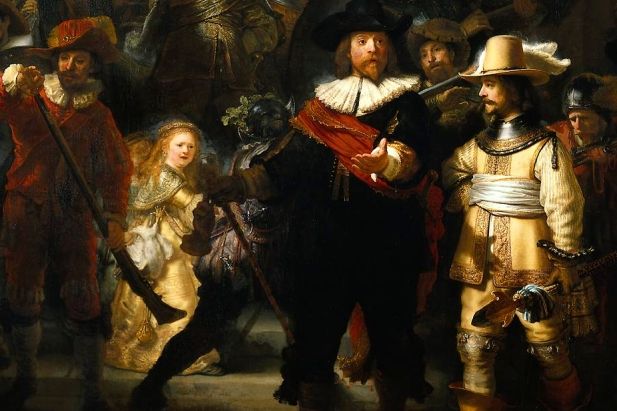


| |
The Night Watch (De Nachtwacht) by Rembrandt   
As portrait painter, in figure pictures of the highest class, and in smaller subjects, both sacred and secular, the Dutch painter Rembrandt is unrivalled. The "Sortie of Banning Cocks Company" is one of those works.
For many years the painting was known as the "Night Watch" a more than usually absurd popular name, inasmuch as the scene is in the sunlight.
A commission was undertaken by Rembrandt in 1642 to paint Captain Frans Banning Cock and his company of arquebusiers. They ordered and expected to receive a group of portraits in which each man should have full share of light and prominence. Rembrandt painted a picture for all time.
The central object is the captain, cane in right hand, left hand extended, engaged in active converse with his lieutenant, Van Ruijtenburg. He is in dark costume, his companion in light. The strong sunlight is shown by the shadow of his hand as it falls upon his comrade. To his right a man loads a gun. In the background are ensigns and pike-men, coming forth from the guard-house, and on the right is a drummer. But how full the painting is of action! Every figure is instinct with life, and you almost expect to see the captain and his comrade take their next step forward.
The painting hangs in the Rijks Museum, in the full glory of its marvellously rich colouring and mysterious light and shade, the picture is one of the most fascinating that eye can look upon. "The difference between this picture" writes Vosmaer, the great biographer of Rembrandt, "and all other pictures of this kind that had been seen in Holland, greatly struck Rembrandt's contemporaries. The old painters generally arranged their characters in two or three lines in such a way as to give each head equal distinction, often without picturesque effect and without action. Ravenstein and Hals only had made use of much action. The former had even conceived the idea of making his guards come forth from their guard-house. Rembrandt gave life to his characters, placed them in the midst, full of life and of movement, sacrificed details to obtain effect, subordinated his subject to his art, and finally plunged that scene of reality into the luminous sea of his own imagination, and created a dramatic story instead of giving a cold chronicle. This is one of the secrets of the immense and lasting effect of his work; it is also the secret of every work of high art, be it Greek, or Italian, or modern."
| |
|















